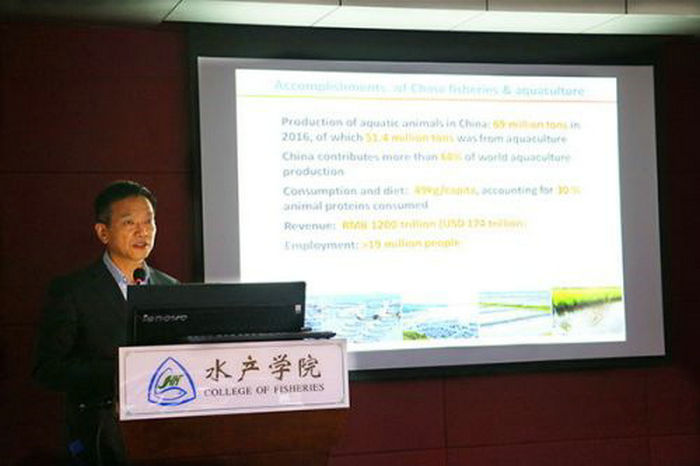
Researcher Hu Qiang giving a presentation
Photo by Song Xuanwei
Hu Qiang, researcher of Institute of Hydrobiology, Chinese Academy of Sciences (IHB, CAS), addressed the HZAU aquaculture forum at the invitation of Professor Gu Zemao (Professor of College of Fisheries and the president of “Green Rice and Green Aquatic Products” Institute) and gave a presentation titled “Microalgae Biotechnology Boosting Green Aquaculture Development and the Role of Microalgae in Green Rice and Green Aquatic Products” in Lecture Hall 109, College of Fisheries on Nov. 16th. The forum, hosted by Professor Gu, attracted nearly 100 teachers and students from College of Fisheries, College of Plant Science & Technology and College of Life Science & Technology.
Professor Hu Qiang pointed out that algae, as the cornerstone of the industrial chain of aquatic products, played an indispensable role in the industry. At present, aquatic industry is facing a series of problems and challenges: water environment, food safety, aquatic product quality and the lack of high-quality fish meal substitutes. Microalgae, however, are such a kind of natural feed for wild aquatic animals and also provide aquatic products with rich nutrition. Therefore, the research on microalgae is of great importance for the whole industry.
The first part of the presentation was mainly about the four roles of microalgae in breeding green aquaculture development: a live bait; feed additive for aquatic products; water cleaner; and wastewater and food waste disposer. Taking the body colour of Cyprinus rubrofuscus as an example, Hu introduced the functions of microalgae, the main research directions and the latest research achievements.
In the second part, he made an introduction to the role that microalgae play in Green Rice and Green Aquatic Products. Hu’s team once produced ulothrix containing carotenoids by means of fermentation, which, as a cheap alternative, greatly reduced production costs. In addition, microalgae can be cultivated into more varieties rich in different pigments through gene knockout. Moreover, they conducted a research to reveal the relation between algae and the productivity of aquatic products by adding different proportions of algae powder into aquatic feed. It shows 5% additives will bring about the highest feeding rate and increase the yield by up to 27%. Algae are important for “Green Rice and Green Aquatic Products” for they preserve moisture and fertility in soil and algae in biofloc make food intake more efficient for fishes and crustaceans.
After the meeting, extensive and heated discussion was held, in which Hu shared his own experience in scientific research and emphasized that industry-oriented scientific research was the key to solutions for industrial problems, particularly those in China’s aquaculture industry. He also encouraged students to stay true to their original goals and study hard.
【Profile】Hu Qiang is the director of Centre for Microalgae Biotechnology, State Development & Investment Corp., Ltd. and the director of the Centre for Microalgal Biotechnology and Biofuels, IHB, CAS. Before returning China, Hu Qiang was a tenured professor at Arizona State University and co-director of the Arizona Centre for Algae Innovation Technology. He is also the associate editor of Algae, editorial board member of both Algal Research and Journal of Applied Phycology. As the president-elect of International Society for Applied Phycology, he serves three-year term from 2017 to 2020 and will then start to serve as the president from 2020 to 2023. He has been engaged in phycology for more than 30 years, covering the fields of algae photosynthesis, physiology and biochemistry, molecular cell biology, photobioreactor system design, algal mass culture, research and development of microalgae biological resources, high value-added biological chemicals, microalgal fixation for industrial carbon dioxide emission and wastewater disposal.
Source: http://news.hzau.edu.cn/2018/1120/53114.shtml
Translated by Zhang Qin
Supervised by Zeng Wenhua
